
The day is finally here. We drive the new 2019 Ford Ranger on the road, in the dirt, with payload, and towing a trailer. This first drive review is focused on the truck’s off-road performance. The truck you see here is a Ranger crew cab XL STX with the FX4 off-road package. Here is how it did on an off-road course in southern California. (Disclaimer: the off-road course was prepared by Ford).
2019 Ford Ranger
All U.S.-spec Rangers are powered by a revised 2.3L turbocharged four-cylinder with a rating of 270 hp and 310 lb-ft of torque. The 10-speed automatic transmission is the only choice.
The engine provides plenty of power and barely noticeable lag, at least when tested in the mountains near San Diego, CA. The character of the turbocharged engine is that of low-end torque. You don’t to need to rev the engine too high in order to get noticeable power and acceleration.
The Ranger extended cab XL 2WD is rated at 1,860 lbs of maximum payload and 7,500 lbs of towing.
The truck tested here is the XL crew cab that starts at $26,520 before destination charges, 4×4 pushes the starting price to $31,775 after destination. STX appearance package cost an additional $2,130. It includes the 101A package that has cruise control, power mirrors, and more. The STX gives you 17-inch rims, black bumpers, fog lamps, and a couple of other touches. Now, the XL STX crew cab 4×4 asking price is $33,905.

The FX4 off-road package adds skid plates, rear locking differential, Terrain Management system, Trail Control system, and off-road tuned suspension/shocks. This hardware and software combination costs $1,295. Final price of the test truck sits at $35,200.
Here is how it performs. The Hankook Dynapro ATM tires work well in loose dirt and mud that we tested the truck in. They are not the most aggressive off-road all-terrain tires, but Ford offers at least two tire choices with the FX4 package. We never got stuck or spun the tires too much on this course.
The Terrain Management (TM) system offers Normal driving mode and three off-road modes for gravel, mud, or sand. Engaging one of the TM off-road modes puts the truck into 4×4 high automatically. Going to 4LO is still a manual process as it requires shifting transmission into neutral. The traction control system worked exceptionally well in order to keep the truck moving even when two wheels were in the air. The rear differential locker was pretty much unnecessary on this course.
Ford’s new Trail Control system is basically slow speed cruise control for off-roading. This system is also available on the 2019 Ford Raptor. It allows the driver to select speeds ranging between 1-20 mph in 4HI (with 1 MPH increments) and 1-10 MPG in 4LO (with 0.5 MPH increments). The system works smoothly and without much noise from the ABS, although you can still hear it. The Ford’s slow speed system felt smoother and quieter than that available on the Toyota Tacoma. Also, Trail Control is available in 2WD and in reverse (1-5 MPH) as well.
The Ranger 4×4 has 8.9 inches of ground clearance, which is comparable to the Toyota Tacoma and other midsize 4×4 trucks the Ranger competes against. The Tacoma 4×4 is listed at 9.4 inches of clearance.
The FX4 shocks and suspension are well-sorted, but don’t expect it to perform as good as the FOX 2.5-inch shocks in the Tacoma TRD Pro. Naturally, those shocks are more expensive. The Ranger FX4 ride is well dampened, but you can still tell you are driving a pickup truck with no load in the bed as the rear gives a little bounce from time to time.
Please stay tuned for more on-road reviews, real-world MPG tests, towing, and more off-roading.
















![Which is More Reliable: 3.5L EcoBoost or 5.0L V8? [Reader Question] Second-generation 3.5-liter EcoBoost engine](https://tfltruck.com/wp-content/uploads/2016/05/Second-generation-35-liter-EcoBoost-engine.jpg)
![Which Silverado Engine to Get: 5.3L or 6.2L V8? [Ask TFLTruck] 2016 chevy silverado](https://tfltruck.com/wp-content/uploads/2015/10/2016-chevy-silverado-grille.jpg)
